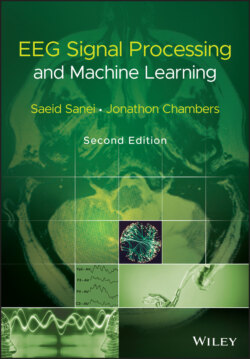Читать книгу EEG Signal Processing and Machine Learning - Saeid Sanei - Страница 76
4.6 Empirical Mode Decomposition
ОглавлениеEmpirical mode decomposition (EMD) may be considered as a multiresolution signal decomposition technique. EMD is an adaptive time–space analysis method suitable for processing nonstationary and nonlinear time series. EMD partitions a series into ‘modes’ namely, intrinsic mode functions (IMFs) in the time domain. Like Fourier and WTs EMD does not follow any physical concept. However, the modes may provide insight into various signals contained within the data and have distinct frequency bands/components.
EMD is based on The Hilbert–Huang transform (HHT) which is a way to decompose a signal into IMFs along with a trend and obtain IF data. Its difference from other common transforms like the Fourier transform, is that the HHT is more like an algorithm (an empirical approach) that can be applied to a data set, rather than a theoretical tool.
IMF represents a simple oscillatory mode as a counterpart to the simple harmonic function, but instead of constant amplitude and frequency in a simple harmonic component, an IMF can have variable amplitude and frequency along the time axis.
The procedure of extracting an IMF is called sifting. The sifting process is as follows [25, 26]:
1 Identify all the local extrema in the test data.
2 Connect all the local maxima by a cubic spline line as the upper envelope.
3 Repeat the procedure for the local minima to produce the lower envelope.
The upper and lower envelopes should cover all the data between them. Their mean is m 1. The difference between the data and m 1 is the first component d 1:
(4.77)
Ideally, d 1 should satisfy the definition of an IMF, since the construction of d 1 described above should have made it symmetric and having all maxima positive and all minima negative. After the first round of sifting, a crest may become a local maximum. New extrema generated in this way actually reveal the proper modes lost in the initial examination. In the subsequent sifting process, d 1 can only be treated as a proto‐IMF. In the next step, d 1 is treated as data:
(4.78)
After repeated sifting up to k times, d 1 becomes an IMF, i.e.:
(4.79)
C 1 = d 1k is considered as the first IMF of the signal x(t).
The iteration above can be stopped in different ways such as when the power (standard deviation) of the difference (between current and previous iteration) signal becomes less than a predefined threshold, or when the number of iterations reaches a reasonable number [27].
For calculation of the other IMFs:
(4.80)
The residue r 1 is then treated as the new signal and the same processing is applied to that. Therefore
(4.81)
The sifting process finally stops when the residue, rn , becomes a monotonic function from which no more IMFs can be extracted. From the above equations, it is induced that:
(4.82)
This results in decomposition of the data into n‐empirical modes [25, 26].
Ensemble EMD (EEMD) is a noise assisted data analysis method. EEMD consists of ‘sifting’ an ensemble of white noise‐added signal. EEMD can separate scales naturally without any a priori subjective criterion selection as in the intermittence test for the original EMD algorithm. Complete ensemble EMD with adaptive noise (CEEMDAN) is a variation of the EEMD algorithm that provides an exact reconstruction of the original signal and a better spectral separation of the IMFs.
